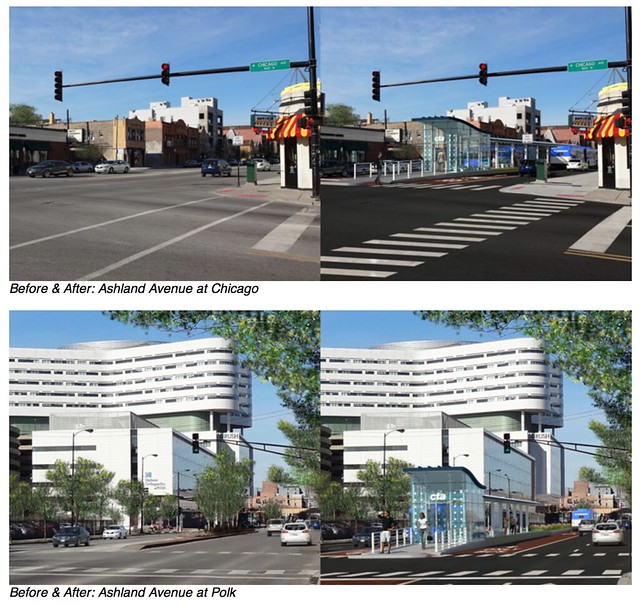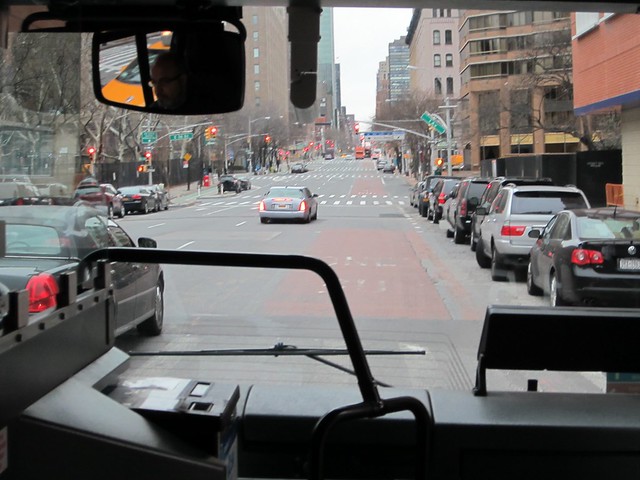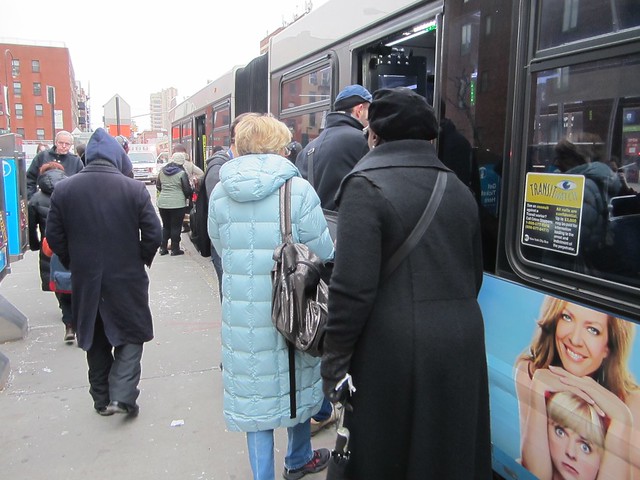Last Sunday, on a trip to New York, I rode the M15 Select Bus Service route on First Avenue in Manhattan. SBS incorporates components of bus rapid transit but it doesn't rise to the level of real BRT, according to standards laid out by the Institute for Transportation and Development Policy. Riding the M15 from 14th Street to 67th Street, I could tell that SBS is a significant improvement over typical bus service, but I also got a sense of its limitations. This revealed a lot about Chicago's BRT plans, and the reasoning behind the proposed design for BRT on Ashland Avenue. Simply put, Ashland BRT will avoid the shortcomings of SBS.
BRT on Ashland will be faster than SBS and less prone to delays caused by people parking in the bus lane or idling tour buses. And it will be easier for people to pay fares, too. Here's why.
With SBS, you arrive at the stop (they're between five and ten blocks apart, or about a quarter to half a mile) and insert your Metrocard into the SBS fare machine on the sidewalk. The machine issues a receipt to show a fare inspector (if they come aboard). This process speeds up boarding: Passengers can board at any door, without being slowed by a queue of people dipping their transit cards. However, it also means passengers have to spend some time getting a receipt before a bus arrives.
Ashland BRT will also have pre-paid boarding but since there will be standalone, bounded stations, it will be possible to use turnstiles, like BRT systems in Mexico and South America. This would eliminate the extra step of collecting a receipt and spare bus riders the occasional frustration of watching a bus pull up and drive away while they press buttons on the receipt machine.
The M15 route in NYC has dedicated bus lanes (some of which are only in effect during peak periods), but since they're next to the parking lane, bus drivers have to navigate around people trying to parallel park or turn right. In some locations, like at the United Nations building, tour buses were standing near the bus stop. Still, despite the enormous traffic volumes in NYC -- I've never seen anything like it in Chicago -- buses are moving faster. And the bus lanes haven't affected average vehicle speeds, which have also increased, according to taxi GPS data.
The center-running bus lanes proposed for Ashland BRT will not have the shortcomings of the SBS bus lanes. They will be in effect at all times. And most importantly, they will not conflict with drivers trying to access the curb. That will mean fewer stops and starts, less weaving through traffic, faster service, and greater reliability.

The center-running lanes are a big reason why Ashland BRT will be the best in the nation – perhaps the first that should achieve ITDP's gold standard. And the reason that "gold standard" BRT matters is that people will start to think taking the bus is a good idea.
Today, riding the bus is perceived as second-class transportation because our streets are designed to treat bus service that way. We have streets that allow each car commuter to infringe on the ability of transit riders to reliably get to work on time. Bus bunching doesn't occur because the CTA is incompetent -- it happens because we let too many cars get in the way. Ashland BRT will create a more equitable street and level the playing field between transit and driving.






